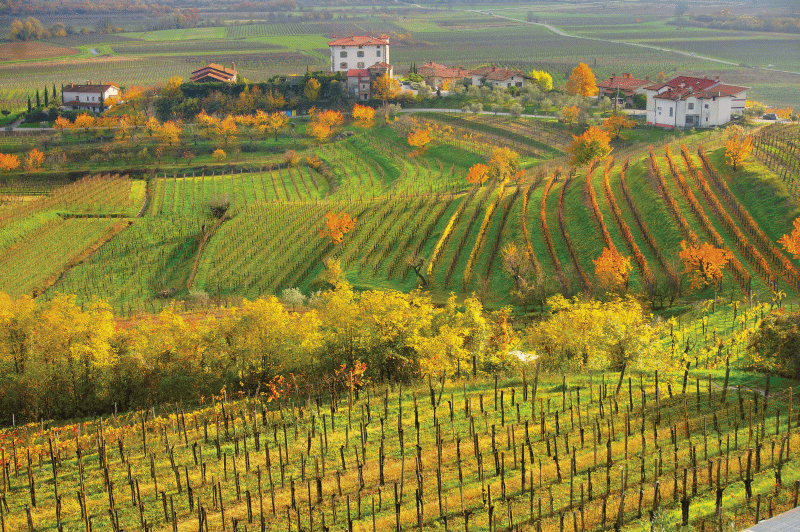HERE'S A TRIVIA question for the self-acknowledged wine geek: which wine region in the world has the most autochthonous (i.e., native) grape varieties?
The answer, which may surprise you, is Friuli Venezia Giulia. To locate it, think of the map of Italy, which resembles a limb in a boot. Well, to put it indelicately, Friuli, in the extreme northeast of Italy, would be the buttock: 7,845 square kilometres of mountainous landscape bordering on Austria, Slovenia and the Adriatic Sea. Here you will find the Dolomites.
While most wine enthusiasts think of Friuli as a white wine region producing delicious dry Friulano, Ribolla Gialla and Malvasia Istriana — as well as three of Italy’s best dessert wines, Verduzzo, Ramandolo and Picolit — the region boasts a bewildering number of indigenous red varieties that even the most ardent wine lover may never have heard of.
In his monumental book Native Wine Grapes of Italy, Ian D’Agata writes about a seven-year DNA study between 2001 and 2008 on 178 grape varieties. The researchers came to the conclusion that 38 varieties (21 red and 17 white) were to be found only in Friuli, “and only 15 had been previously described in existing literature and ancient documents.”
The names of the most significant red varieties trip off the tongue with the mellifluous sound of the Italian language: Refosco dal Peduncolo Rosso, Schioppettino, Terrano, and Tazzelenghe, which in the delightful local dialect means “tongue cutter,” so-called because of its searing acidity and gripping tannins.
Friuli Venezia Giulia may lack the international recognition factor of Chianti, Piemonte and neighbouring Veneto, but it can rightly claim to be the nursery for the entire Italian wine industry. The region currently produces 80 per cent of all of Italy’s rootstocks, which amounts to 20 per cent of the total amount of rootstocks propagated in the EU counties and 25 per cent of what the rest of the world produces.
Why, you might ask, is this so significant? You have to go back to around 1860 for the answer — the dreaded phylloxera blight, which was the greatest scourge of the grapevine ever to be visited on this planet.
The phylloxera louse is a tiny pale yellow sap-sucking aphid that feeds on the roots and leaves of grape vines. Their voracious appetite for the tender roots gradually cuts off the flow of nutrients and water to the vine and eventually kills it.
The disease was carried to Europe in 1860 on the roots of a Vitis labrusca grapevine variety called Isabella. Ironically, phylloxera started in the United States, but the hardy native North American vines became immune to it. The French, who had a terrible problem with powdery mildew, decided to import this labrusca variety to combat the problem. But a shipment of Isabella vines had the phylloxera aphids in the roots, and once they were planted the aphids began to feast on the unprotected vineyards of France.
The blight began in the Rhône Valley and worked its way north, laying waste the grapevines throughout Europe for the next 40 years.
French farmers watched their vineyards die as the leaves of their vines turned yellow. They tried every remedy to combat the plague, including burying live frogs under the vines and pouring boiling water on the roots.
Eventually a cure was found and it was not unlike the vaccination of the vine: the growers imported the phylloxera-resistant North American rootstock and grafted onto it their Chardonnays, Cabernet Sauvignons, Pinot Noirs and Syrahs.
Today, virtually all of Europe’s grape vines are planted on North American rootstock. I say “virtually all” because there are some parcels of vines grown in sandy soil in which the phylloxera louse cannot survive. There are parts of southern Spain (Jumilla) and Portugal (Colares) with particularly sandy soils that escaped the scourge.
The most famous pre-phylloxera vineyard in the world, perhaps, is Bollingers Vieilles Vignes Françaises,
whose champagne vines are still on their original rootstock. When Bollinger’s vineyard workers want to create a new vine they merely bury a “cane,” or arm of the vine, in earth, and when it starts to sprout they cut if off from the mother vine; this is a practice likewise used in Chile, which is also phylloxera-free.
It has been estimated that the cost of phylloxera to France’s economy in the four decades from 1858 or so was two and half times the cost of the Franco-Prussian War (which was five billion francs).
Phylloxera, the cancer of the vine, is ever present. A genetically mutated form appeared in California in the 1980s and attacked the ARx1 rootstocks that had been recommended by the Department of Agriculture and the premier wine university, University of California, Davis. This particular rootstock was previously thought to be immune from the disease. It cost the wineries millions of dollars, as they had to grub out the infected vines and replant on newly developed rootstocks.
So next time you visit the vineyards of Europe, listen closely to the vines. Since one in four of them is planted on rootstock raised in Friuli Venezia Giulia, you might hear them speaking in Friulian.
Tony Aspler is the author of 17 books on wine, including his latest, Canadian Wineries.





